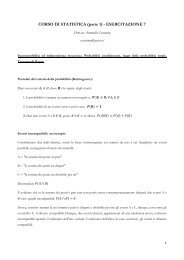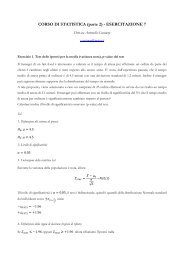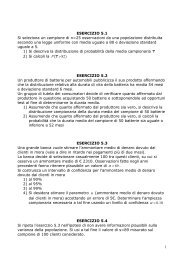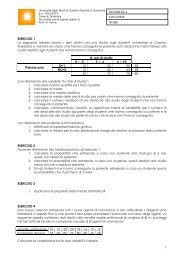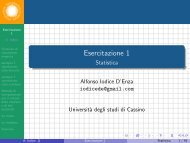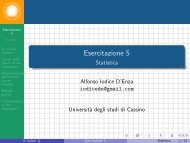moda, media e quantili per tabelle di frequenza
moda, media e quantili per tabelle di frequenza
moda, media e quantili per tabelle di frequenza
Create successful ePaper yourself
Turn your PDF publications into a flip-book with our unique Google optimized e-Paper software.
12-esimo <strong>per</strong>centile = ( ∗<br />
)= . = 21<br />
83-esimo <strong>per</strong>centile = ( ∗<br />
)= . = 29<br />
Me<strong>di</strong>a aritmetica: = ∑ <br />
∗ <br />
Soluzione Q.2<br />
= ∗∗∗⋯<br />
<br />
Distribuzione in classi <strong>per</strong> la variabile Statura<br />
= 25.5<br />
Statura (classi) = + <br />
(150, 160] 4 0.2 4 0.2<br />
() 155 10 0.4<br />
() 0.02<br />
(160, 170] 9 0.45 13 0.65 165 10 0.9 0.045<br />
(170, 180] 6 0.30 19 0.95 175 10 0.6 0.03<br />
(180, 190] 1 0.05 20 1 185 10 0.1 0.005<br />
Totale (n) 20 1<br />
Classe <strong>moda</strong>le: (160,170] essendo un carattere quantitativo continuo organizzato in classi bisogna in<strong>di</strong>viduare la<br />
<strong>moda</strong>lità a cui è associata la più alta densità <strong>di</strong> <strong>frequenza</strong> (assoluta o relativa). Nota <strong>per</strong>ò che in questo caso le<br />
classi sono equiampie e quin<strong>di</strong> è possibile far riferimento alle sole frequenze.<br />
La <strong>me<strong>di</strong>a</strong> aritmetica <strong>per</strong> la variabile Statura organizzata in classi è pari a:<br />
<br />
<br />
= ∑ ∗ <br />
<br />
= ()()⋯<br />
167 cm<br />
<br />
Me<strong>di</strong>ana: <strong>per</strong> dati quantitativi continui organizzati in classi, la determinazione della <strong>me<strong>di</strong>a</strong>na avviene nel modo<br />
seguente:<br />
1. In<strong>di</strong>viduazione della classe <strong>me<strong>di</strong>a</strong>na ( , ): in tale classe cadrà la <strong>moda</strong>lità assunta dall'unità statistica che<br />
occupa la posizione centrale della <strong>di</strong>stribuzione or<strong>di</strong>nata delle <strong>moda</strong>lità. In tal caso corrisponde a (160,170]<br />
2. Il valore che assume la <strong>me<strong>di</strong>a</strong>na nella classe in<strong>di</strong>viduata deve essere calcolato tramite l’o<strong>per</strong>azione <strong>di</strong><br />
interpolazione sulla funzione <strong>di</strong> ripartizione empirica (se si utilizzano le frequenze relative cumulate). Tale<br />
proce<strong>di</strong>mento sarà utile anche <strong>per</strong> la ricerca dei quartili. Utilizzando le frequenze cumulate relative, in generale<br />
sappiamo che il particolare quantile può essere determinato con la seguente:<br />
dove = nel nostro caso <strong>per</strong> cui = 0.5<br />
Avremo quin<strong>di</strong>:<br />
= + − ( − <br />
<br />
)<br />
<br />
3



